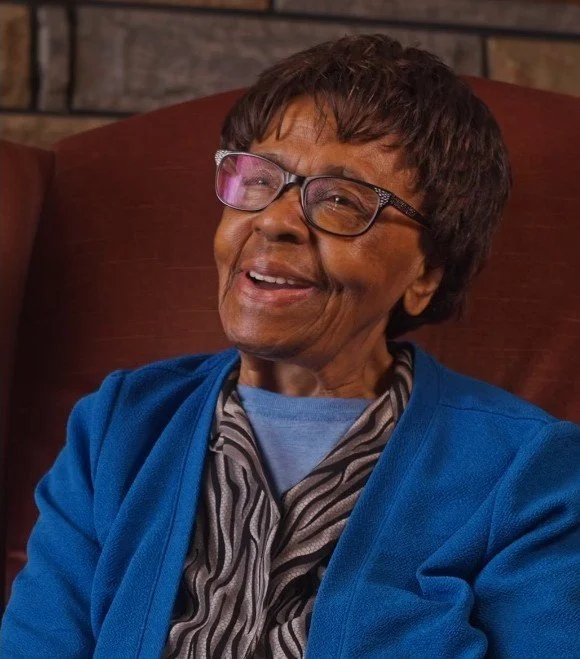One size does not fit all
Efficiency NS brings retrofits to traditionally underserved communities dealing with challenging title and property ownership issues.
Program participant, Marion Bund, sits comfortable in her home, post retrofit. A home that she built alongside her husband, in 1979. Photo courtesy of Efficiency Nova Scotia.
Efficiency Nova Scotia has a lot of programs, some aimed at improved insulation, installing smart thermometers and appliances, replacing oil furnaces with heat pumps, and installing solar panels on Nova Scotian roofs. While many are rebate-based, there’s also HomeWarming, which offers free energy efficiency upgrades to lower income households. That helps those Nova Scotians live more comfortably while saving money on heating bills — all with no-charge improvements.
But whether their support is financial, technical, or administrative, it’s supposed to be accessible to all Nova Scotians, giving every household the chance to spend less money, waste less power, and emit less carbon.
In practice, however, some have easier access than others. A well-meaning criteria for many of these programs, for example, is that residents demonstrate ownership of the building they’d like to retrofit. For most, this is a simple matter of dusting off their land title. For some, it’s like coming up against a brick wall.
“The ability to actually demonstrate proof of home ownership isn’t always an easy task in some communities,” says Janet Tobin, communications manager with Efficiency NS.
Among Mi’kmaw First Nations, for example, there may be hundreds of homes deserving of efficiency upgrades, including heat pumps, for homes that don’t necessarily belong to the families living inside them. Legally, the buildings might belong to the local First Nation, and as such don’t qualify for support, leaving the tenants unable to apply to HomeWarming, becoming unintended victims of a technicality.
The Mi’kmaw Home Energy Efficiency Program (MHEEP), launched by Efficiency NS in 2018, overcame this obstacle by partnering with First Nations directly, and tailoring eligibility criteria to ownership mechanisms on the ground. With simple cooperation and consultation, MHEEP has enabled retrofits in 1,400 homes across 13 nations, avoiding 59,600 tonnes of emitted CO2.
Efficiency NS recognizes the ownership challenges that have prevented African Nova Scotian communities from involvement in HomeWarming and other programs. In response they created the African Nova Scotian Communities Retrofit Program, available to African Nova Scotians living in the townships of Preston and Guysborough; specifically North Preston, East Preston, Cherry Brook, Lake Loon, Sunnyville, Lincolnville, Upper Big Tracadie, Monastery, and Mulgrave. It was launched in late 2024 and designed to also work around home ownership problems.
“For more than 200 years,” says program manager Sherry Smith, “many African Nova Scotians have been living on land passed down by their ancestors without clear land title.”
Even where land has been occupied for generations, governments have routinely denied clear, legal land title to many African Nova Scotians. This leaves many families in the bizarre position of occupying homes they don’t legally own, on land which could be — and often was — sold out from under them.
Sheridan Gould, owner of John Boy Gould’s Electrical, cleans an HRV vent cover. Photo courtesy of Efficiency Nova Scotia.
The best documented example is Africville, the African Nova Scotian community expropriated by — then subsumed by — the City of Halifax in the 1960s. When its residents were forcibly relocated, many received a $500 pittance in exchange for their homes (and land) because they couldn’t present title. Nor was title forthcoming for the land to which they were forcibly relocated.
Among other things, the lack of title disqualifies hundreds of households from acquiring a mortgage, selling their land, or accessing support for retrofits through Efficiency NS — including the free HomeWarming program. It’s an issue for some African Nova Scotian households to this day, a legal legacy which can be expensive to straighten out. The Government of Nova Scotia launched its Land Titles Initiative in 2017 to shoulder much of the financial burden of righting this old wrong, but many African Nova Scotians still live without title due to a number of factors, including expense, time, and general lack of program awareness.
The African Nova Scotian Communities Retrofit Program isn’t about offering anything new to these households. It’s about helping them overcome barriers to accessing the same incentives, supports, and equipment Efficiency NS offers to everyone else. A cornerstone of the program is to prove an applicant’s ownership of their property (a case-by-case process) without recourse to title as well as to offer administrative assistance if needed.
While there are additional incentives and support for low- and moderate-income households, all homeowners in the eligible communities can apply.
This is a young program, but it’s already received 249 applications. Support varies based on situation and on household income, but for the time being, the program has no end date. Anyone unsure of their eligibility is encouraged to give Efficiency NS a call, title or no title.
“Every home is unique,” Smith says. “Many have become 30 per cent more energy efficient with recommended upgrades. Our oldest home so far was built in 1725.”
Climate Stories Atlantic is an initiative of Climate Focus, a non-profit organization dedicated to covering stories about community-driven climate solutions.
Sign up for notifications of our latest free articles. You can unsubscribe at any time.


